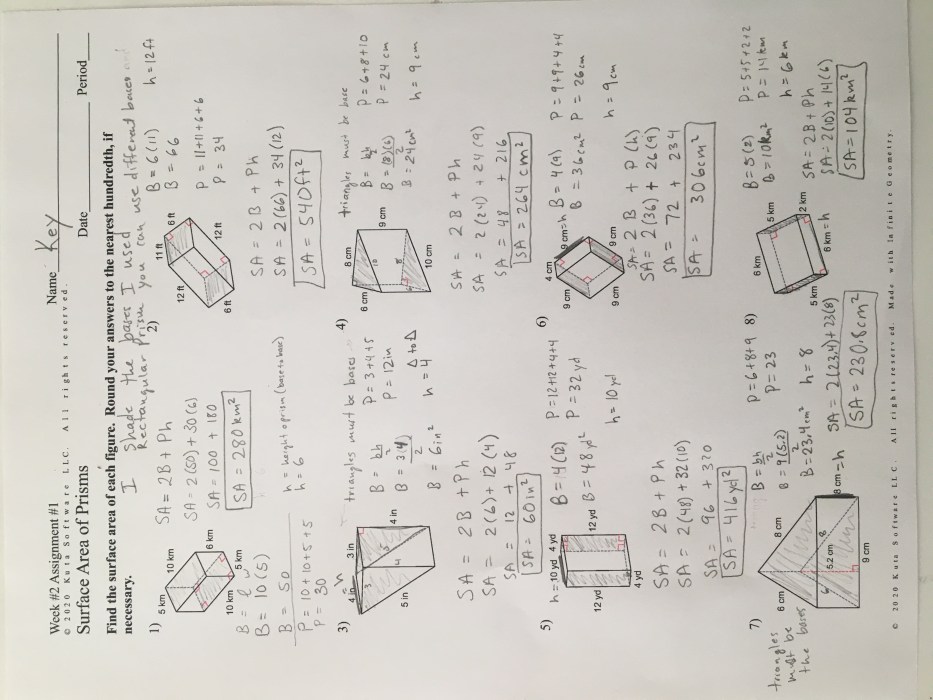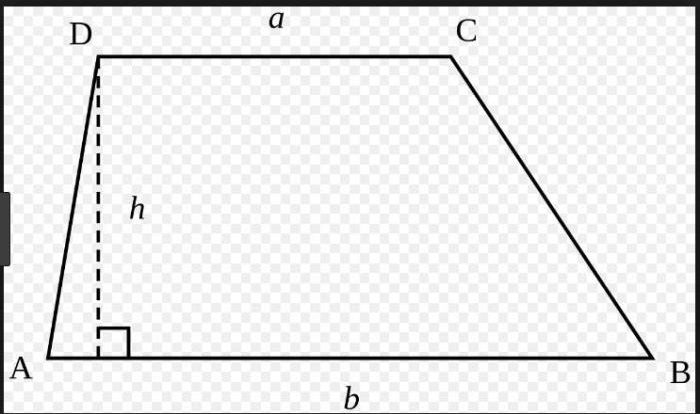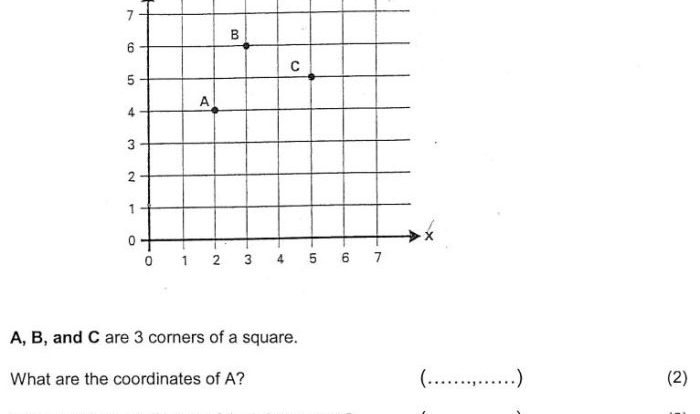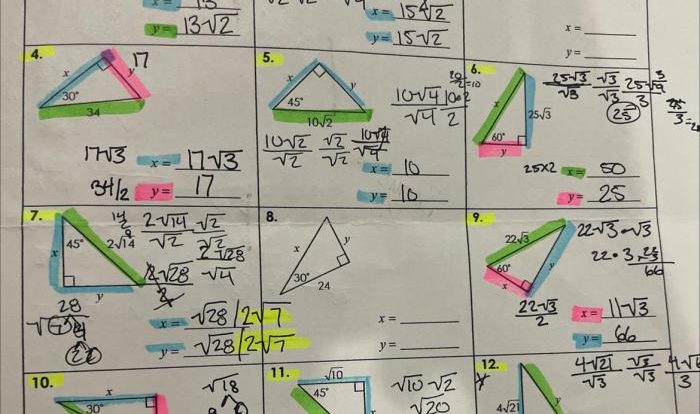Embark on a journey into the realm of surface area with our surface area homework 3 answer key. Dive into the captivating world of geometry, where shapes dance with formulas and applications abound. Let’s unravel the secrets of surface area, its significance, and its optimization techniques.
From understanding the concept of surface area to exploring its applications in real-world scenarios, this answer key serves as a comprehensive guide to enhance your geometric prowess. Prepare to unlock the mysteries of surface area and expand your knowledge horizons.
Surface Area Calculations
Surface area refers to the total area of all exposed surfaces of a three-dimensional object. It is a fundamental geometric property used in various fields, including engineering, architecture, and physics.
Calculating the surface area of different shapes is essential for determining the amount of material needed for construction, estimating the volume of enclosed space, and analyzing heat transfer, among other applications.
Cube
A cube is a regular polyhedron with six square faces. The surface area of a cube with side length ais given by the formula:
a2
Sphere
A sphere is a three-dimensional object with a perfectly round surface. The surface area of a sphere with radius ris given by the formula:
πr2
Cylinder
A cylinder is a three-dimensional object with two parallel circular bases and a curved surface. The surface area of a cylinder with base radius rand height his given by the formula:
πr( r+ h)
Applications of Surface Area: Surface Area Homework 3 Answer Key
Surface area plays a crucial role in various real-world applications and biological processes. Understanding its significance enables us to comprehend the behavior of systems and optimize their performance.
Heat Transfer
Surface area is a key factor in heat transfer. The larger the surface area, the greater the rate of heat transfer. This principle is applied in various applications, such as:
- Radiators:Designed with a large surface area to maximize heat dissipation from hot water or steam.
- Air conditioners:Utilize coils with a large surface area to facilitate efficient heat exchange with the surrounding air.
- Industrial heat exchangers:Employ extended surfaces to enhance heat transfer between fluids.
Fluid Dynamics
Surface area is also significant in fluid dynamics. It influences the drag force experienced by objects moving through fluids.
- Aircraft wings:Designed with a streamlined shape to minimize drag by reducing the surface area exposed to airflow.
- Ship hulls:Shaped to minimize drag and maximize speed by reducing the wetted surface area (the surface area in contact with water).
- Wind turbines:Utilize blades with a large surface area to capture more wind energy and generate electricity.
Biological Processes, Surface area homework 3 answer key
Surface area is essential for many biological processes:
- Respiration:The surface area of the lungs allows for efficient gas exchange between the blood and the air.
- Photosynthesis:The surface area of leaves maximizes the absorption of sunlight for photosynthesis.
- Diffusion:The surface area of cell membranes facilitates the movement of molecules across the membrane.
Surface Area and Volume
Surface area and volume are two fundamental geometric properties that play a crucial role in various scientific and engineering applications. The relationship between these two quantities is particularly important in understanding the behavior of physical systems and optimizing their performance.
In general, for a given shape, the surface area increases as the volume increases. However, the rate at which the surface area increases relative to the volume depends on the shape itself. For example, a sphere has a relatively small surface area compared to its volume, while a cube has a relatively large surface area compared to its volume.
Surface Area Optimization
Optimizing the surface area for specific applications is often crucial. For instance, in heat transfer applications, a large surface area allows for efficient heat exchange. In biological systems, the surface area of cells and organs influences their ability to absorb nutrients and exchange gases.
- Heat exchangers:Designing heat exchangers with a large surface area relative to their volume enhances heat transfer efficiency.
- Biological systems:Cells with a large surface area-to-volume ratio can absorb more nutrients and exchange gases more efficiently.
- Catalytic reactions:Catalysts with a high surface area provide more active sites for reactions, increasing the reaction rate.
Surface Area-to-Volume Ratio
The surface area-to-volume ratio is a dimensionless quantity that provides insights into the relative size of the surface area compared to the volume. It is particularly important in understanding the behavior of small systems, such as cells and nanoparticles.
- Small systems:Small systems tend to have a high surface area-to-volume ratio, which can significantly influence their properties and behavior.
- Biological implications:The surface area-to-volume ratio affects the rate of nutrient absorption, waste removal, and gas exchange in cells.
- Nanotechnology:Nanoparticles with a high surface area-to-volume ratio can exhibit unique properties and applications in fields such as catalysis and drug delivery.
Surface Area Optimization

Surface area optimization involves techniques to maximize or minimize the surface area of a given object. It plays a crucial role in various fields, including engineering and design, where controlling surface area can enhance performance and efficiency.
One common technique for increasing surface area is to create porous structures. Porous materials have a high surface area due to the presence of numerous interconnected pores, which can enhance absorption, adsorption, and catalytic reactions. For example, activated carbon is a highly porous material used in water filtration and gas adsorption applications.
Increasing Surface Roughness
Increasing surface roughness can also increase surface area. Rough surfaces have more surface irregularities, creating additional surface area for interactions. This technique is commonly used in heat exchangers to enhance heat transfer by increasing the surface area available for heat exchange.
Trade-offs in Surface Area Optimization
While surface area optimization can provide benefits, it also involves trade-offs. Increasing surface area may lead to increased material usage, which can affect cost and weight. Additionally, rougher surfaces may be more susceptible to wear and tear, requiring careful consideration of the application and environment.
Surface Area Measurement Techniques
Surface area measurement is crucial in various fields, including research and industry. Different methods are employed to determine the surface area of objects, each with its advantages and limitations.
Geometric Formulas
Geometric formulas are commonly used to calculate the surface area of regular objects with well-defined shapes, such as cubes, spheres, and cylinders. These formulas provide accurate results and are relatively easy to apply. However, they are limited to objects with simple geometries.
Experimental Techniques
Experimental techniques are used to measure the surface area of irregular objects or objects with complex geometries. These methods involve physical measurements and can be classified into two main categories:
Direct Measurement
- Planimetry:This method involves tracing the object’s Artikel onto a grid paper and counting the number of squares covered to estimate the surface area.
- Microscopy:High-resolution microscopes can be used to capture images of the object’s surface, which can then be analyzed to determine the surface area.
Indirect Measurement
- Gas adsorption:This technique involves exposing the object to a known volume of gas and measuring the amount of gas adsorbed onto its surface. The surface area can be calculated from the volume of gas adsorbed.
- Liquid displacement:This method involves submerging the object in a liquid and measuring the change in liquid volume. The surface area can be calculated from the volume of liquid displaced.
Applications of Surface Area Measurement
Surface area measurement has numerous applications in research and industry, including:
- Catalysis:Surface area is a crucial factor in catalysis, as it affects the number of active sites available for reactions.
- Adsorption and separation:Surface area plays a role in adsorption and separation processes, as it determines the amount of material that can be adsorbed or separated.
- Drug delivery:The surface area of drug particles influences their dissolution rate and bioavailability.
Popular Questions
What is surface area?
Surface area refers to the total area of all surfaces that enclose a three-dimensional object.
How do I calculate the surface area of a cube?
To calculate the surface area of a cube, use the formula: 6 – (side length)^2.
What are some real-world applications of surface area?
Surface area plays a crucial role in heat transfer, fluid dynamics, and biological processes like respiration and photosynthesis.


